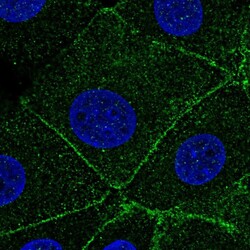Antibody data
- Antibody Data
- Antigen structure
- References [12]
- Comments [0]
- Validations
- Western blot [1]
- Immunocytochemistry [1]
Submit
Validation data
Reference
Comment
Report error
- Product number
- HPA004334 - Provider product page

- Provider
- Atlas Antibodies
- Proper citation
- Atlas Antibodies Cat#HPA004334, RRID:AB_1078215
- Product name
- Anti-ARPC1A
- Antibody type
- Polyclonal
- Description
- Polyclonal Antibody against Human ARPC1A, Gene description: actin related protein 2/3 complex subunit 1A, Alternative Gene Names: Arc40, SOP2Hs, SOP2L, Validated applications: WB, IHC, ICC, Uniprot ID: Q92747, Storage: Store at +4°C for short term storage. Long time storage is recommended at -20°C.
- Reactivity
- Human
- Host
- Rabbit
- Conjugate
- Unconjugated
- Isotype
- IgG
- Vial size
- 100 µl
- Concentration
- 0.1 mg/ml
- Storage
- Store at +4°C for short term storage. Long time storage is recommended at -20°C.
- Handling
- The antibody solution should be gently mixed before use.
Submitted references PI 3-Kinase and the Histone Methyl-Transferase KMT2D Collaborate to Induce Arp2/3-Dependent Migration of Mammary Epithelial Cells
Inherited ARPC5 mutations cause an actinopathy impairing cell motility and disrupting cytokine signaling
ERK3/MAPK6 dictates CDC42/RAC1 activity and ARP2/3-dependent actin polymerization
ARPC5 isoforms and their regulation by calcium-calmodulin-N-WASP drive distinct Arp2/3-dependent actin remodeling events in CD4 T cells
ARPC1B binds WASP to control actin polymerization and curtail tonic signaling in B cells
MICAL2 enhances branched actin network disassembly by oxidizing Arp3B-containing Arp2/3 complexes
Cryo-EM of human Arp2/3 complexes provides structural insights into actin nucleation modulation by ARPC5 isoforms
Enhanced Dendritic Actin Network Formation in Extended Lamellipodia Drives Proliferation in Growth-Challenged Rac1P29S Melanoma Cells
Cortical branched actin determines cell cycle progression
Loss of ARPC1B impairs cytotoxic T lymphocyte maintenance and cytolytic activity
Loss of the Arp2/3 complex component ARPC1B causes platelet abnormalities and predisposes to inflammatory disease
Isoform diversity in the Arp2/3 complex determines actin filament dynamics
Rysenkova K, Gaboriaud J, Fokin A, Toubiana R, Bense A, Mirdass C, Jin M, Ho M, Glading E, Vacher S, Courtois L, Bièche I, Gautreau A
Cells 2024;13(10):876
Cells 2024;13(10):876
Inherited ARPC5 mutations cause an actinopathy impairing cell motility and disrupting cytokine signaling
Nunes-Santos C, Kuehn H, Boast B, Hwang S, Kuhns D, Stoddard J, Niemela J, Fink D, Pittaluga S, Abu-Asab M, Davies J, Barr V, Kawai T, Delmonte O, Bosticardo M, Garofalo M, Carneiro-Sampaio M, Somech R, Gharagozlou M, Parvaneh N, Samelson L, Fleisher T, Puel A, Notarangelo L, Boisson B, Casanova J, Derfalvi B, Rosenzweig S
Nature Communications 2023;14(1)
Nature Communications 2023;14(1)
ERK3/MAPK6 dictates CDC42/RAC1 activity and ARP2/3-dependent actin polymerization
Bogucka-Janczi K, Harms G, Coissieux M, Bentires-Alj M, Thiede B, Rajalingam K
eLife 2023;12
eLife 2023;12
ARPC5 isoforms and their regulation by calcium-calmodulin-N-WASP drive distinct Arp2/3-dependent actin remodeling events in CD4 T cells
Sadhu L, Tsopoulidis N, Hasanuzzaman M, Laketa V, Way M, Fackler O
eLife 2023;12
eLife 2023;12
ARPC1B binds WASP to control actin polymerization and curtail tonic signaling in B cells
Leung G, Zhou Y, Ostrowski P, Mylvaganam S, Boroumand P, Mulder D, Guo C, Muise A, Freeman S
JCI Insight 2021;6(23)
JCI Insight 2021;6(23)
MICAL2 enhances branched actin network disassembly by oxidizing Arp3B-containing Arp2/3 complexes
Galloni C, Carra D, Abella J, Kjær S, Singaravelu P, Barry D, Kogata N, Guérin C, Blanchoin L, Way M
Journal of Cell Biology 2021;220(8)
Journal of Cell Biology 2021;220(8)
Cryo-EM of human Arp2/3 complexes provides structural insights into actin nucleation modulation by ARPC5 isoforms
von Loeffelholz O, Purkiss A, Cao L, Kjaer S, Kogata N, Romet-Lemonne G, Way M, Moores C
Biology Open 2020
Biology Open 2020
Enhanced Dendritic Actin Network Formation in Extended Lamellipodia Drives Proliferation in Growth-Challenged Rac1P29S Melanoma Cells
Mohan A, Dean K, Isogai T, Kasitinon S, Murali V, Roudot P, Groisman A, Reed D, Welf E, Han S, Noh J, Danuser G
Developmental Cell 2019;49(3):444-460.e9
Developmental Cell 2019;49(3):444-460.e9
Cortical branched actin determines cell cycle progression
Molinie N, Rubtsova S, Fokin A, Visweshwaran S, Rocques N, Polesskaya A, Schnitzler A, Vacher S, Denisov E, Tashireva L, Perelmuter V, Cherdyntseva N, Bièche I, Gautreau A
Cell Research 2019;29(6):432-445
Cell Research 2019;29(6):432-445
Loss of ARPC1B impairs cytotoxic T lymphocyte maintenance and cytolytic activity
Randzavola L, Strege K, Juzans M, Asano Y, Stinchcombe J, Gawden-Bone C, Seaman M, Kuijpers T, Griffiths G
Journal of Clinical Investigation 2019;129(12):5600-5614
Journal of Clinical Investigation 2019;129(12):5600-5614
Loss of the Arp2/3 complex component ARPC1B causes platelet abnormalities and predisposes to inflammatory disease
Kahr W, Pluthero F, Elkadri A, Warner N, Drobac M, Chen C, Lo R, Li L, Li R, Li Q, Thoeni C, Pan J, Leung G, Lara-Corrales I, Murchie R, Cutz E, Laxer R, Upton J, Roifman C, Yeung R, Brumell J, Muise A
Nature Communications 2017;8(1)
Nature Communications 2017;8(1)
Isoform diversity in the Arp2/3 complex determines actin filament dynamics
Abella J, Galloni C, Pernier J, Barry D, Kjær S, Carlier M, Way M
Nature Cell Biology 2015;18(1):76-86
Nature Cell Biology 2015;18(1):76-86
No comments: Submit comment
Enhanced validation
- Submitted by
- Atlas Antibodies (provider)
- Enhanced method
- Genetic validation
- Main image

- Experimental details
- Western blot analysis in MCF-7 cells transfected with control siRNA, target specific siRNA probe #1, using Anti-ARPC1A antibody. Remaining relative intensity is presented. Loading control: Anti-PPIB.
- Sample type
- Human
- Protocol
- Protocol
Supportive validation
- Submitted by
- Atlas Antibodies (provider)
- Main image

- Experimental details
- Immunofluorescent staining of human cell line MCF7 shows localization to cytosol & cell junctions.
- Sample type
- Human
 Explore
Explore Validate
Validate Learn
Learn Western blot
Western blot Immunocytochemistry
Immunocytochemistry Immunohistochemistry
Immunohistochemistry